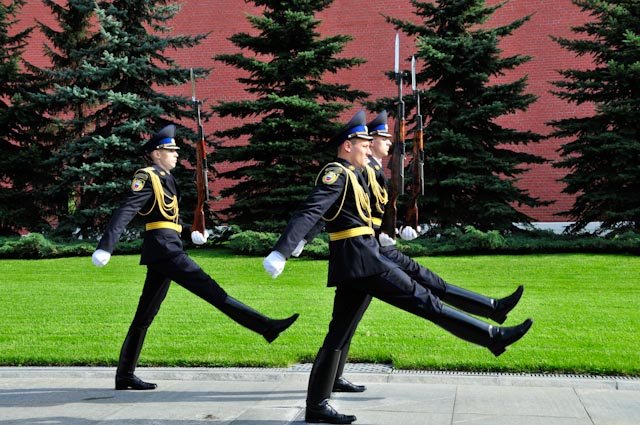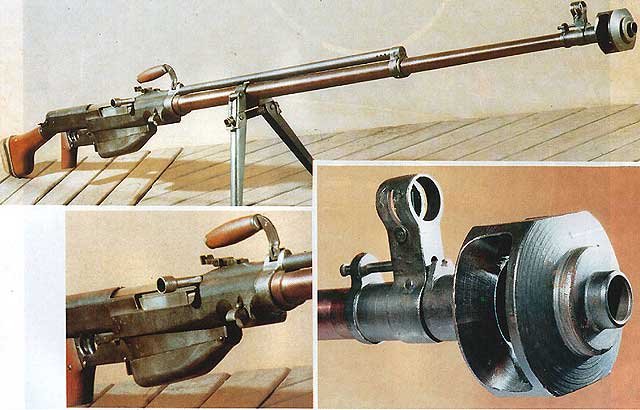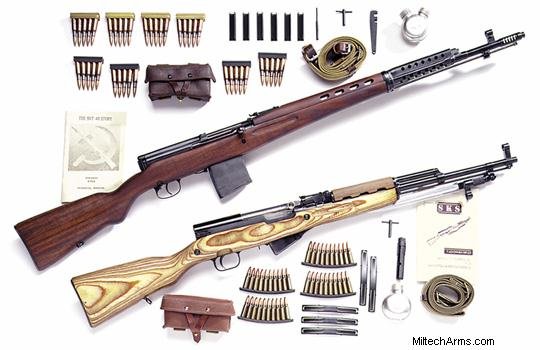
The SKS is a semi-automatic carbine, designed in 1945 by Sergei Simonov It is also known as SKS 45. During the Second World War, Simonov designed some firearms as sub-machine guns that were not produced, also a 14.5 x PTRS-41 anti-tank rifle. 114mm and the well-known AVS-36 caliber 7.62x54mmR that happened to form the basis to establish the shape of the SKS. The semiautomatic SKS rifle was initially hampered by the use of powerful 7.62x54mmR cartridges, the excessive power of these cartridges endangered the operation of rifles like the SVT 40 semiautomatic, also firing cartridges that had excess recoil and the effective range It was about 2000 meters, while most of the fights were at distances of no more than 600-800 meters.

14.5 x 114mm PTRS-41 anti-tank rifle designed by Simonov.

Sergei G. Simonov.
In 1943, from this experience arose the idea of more compact firearms taking into account the effective range of about 500-800 meters or so. Then it would be confirmed by the success of the German assault rifle "Sturmgewehr 44" - the Russians adapted a shorter, less powerful round, the 7.62x39mm M1943 (also known as "7.62 Soviet" or "7.62 short"), for differentiate it from others in several rounds of 7.62 mm caliber). In 1944 some SKS were used in the offensive of Belarus for first tests in a battlefield. After some modifications, it was officially approved and designated the 7.62 Samozaryadnyi Karabin Sistemy Simonova Obrazets 1945 g. (translated, "7.62 Car-system cargo Simonov model year 1945"), would be chosen as the ideal replacement for the SVT-40.

The SVT-40 and its successor the SKS
The SKS rifle is one of the most sold rifles on the market. Due to the excess of millions of these rifles, they are relatively cheap, as well as meticulously cared for. The SKS rifle operates on a short stroke gas piston, the tilt screw design, which shares many features with most modern firearms. After the development of the AK-47 rifle, the SKS rifles were almost abandoned, due to the high production costs, compared to the AK47.

Technical specifications
The SKS uses a conventional design for a carbine, with a wooden butt and without a pistol grip. Many versions have an integrated bayonet that pivots to be fixed, and some have grenade launchers. Like the American M1 carbine, the SKS is shorter and less powerful than the semiautomatic rifles that came before - for example, the Soviet SVS-40, the Gewehr 43 and the US M1 Garand. Some say that the SKS is an assault rifle - on the contrary, it is not because it lacks several details that have the real assault rifles (although there are modern versions more like an assault rifle). It has no ability to select the type of shot (it can not fire bursts) and the original design has no removable magazine. The charger, which is fixed, has a capacity for 10 bullets and is recharged with a comb or introducing the bullets individually. The cartridges can be removed from the magazine by pressing a latch in front of the trigger guard. This opens the magazine underneath and drops the cartridges.

SKS Russian with the brand of the factory Tula
SKS was put into service along with the Kalashnikov AK-47, and was widely used during the first two or three decades after the war. With the increase in the number of the AK-47 and AKM brought into service, the number of the SKS, in the first line services gradually decreased, but some SKS were still used by the infantry units and not second-line of the Soviet Army as late as 1980 and until 1990. At present there are still SKS in their Russian warehouses golds were sold as surpluses in domestic and foreign markets, and the most notable role of the SKS is that it is still used as a ceremonial weapon by the Russian Honor Guard.

Russian Honor Guard carrying SKS carbines.
As with many other Soviet weapons of the post-war era, licenses for the design of SKS were sold or delivered to some countries under the Soviet orvita, such as China, DDR (East Germany), Yugoslavia, Albania and some others . These countries also built a large number of SKS, with some minor derivations from the original design. In Yugoslavia SKS carbines were often equipped with a combined cannon device - grenade launcher. Other variations also existed. Many of the carbines, along with the originals in Russian, were sold as military surpluses during the last decades, both in the original or with the bayonets eliminated.

SKS yugoslavo M59 con bocacha lanzagrandas .
Physically, they are all very similar, although the mouths grenade launchers of the Yugoslav versions, and the longest butt of the Albanian version are quite characteristic. Early versions of Russia and China (Type 56) used a bayonet skewer, while most use a blade type. Many small parts, such as the sights and handles, are unique to several countries.
The first few carbines produced in China during 1955 and 1956 used Russian parts and technology. It is possible that several M59 / 66 Yugoslav carbines with teak butts will be exported to Uruguay and Mozambique. The majority of the Yugoslav carbines use stocks of elm, beech and walnut. They have also been seen in conflicts in Africa, Afghanistan and Iraq. Countries that used the SKS but did not receive manufacturing rights include Afghanistan, Congo, Indonesia, Iraq, Laos, Lebanon, Mongolia, Morocco, Egypt (such as the United Arab Republic), South Yemen, Cuba and Nicaragua.
The SKS has also been used during riots and riots. In the United States, several Korean shopkeepers used this carbine to protect their tents during the Los Angeles riots in 1992.
Although the SKS was only used by the Red Army for about two years, it played an important role in Korea and Vietnam, in addition to other "dirty wars". But it was in Vietnam that the Americans first met the SKS. By the time the US forces arrived in Vietnam, the North Vietnamese army went on to use the modern AK-47. But the Viet Cong guerrillas used the SKS extensively; it was perhaps the closest thing to a standard weapon in its heterogeneous arsenal. The Viet Cong warehouses were SKS portraits most of Chinese origin 56. Many countries stopped using the SKS during the 60s and 70s, although the Chinese police and army continued to use it during the 90s, and even today there are variants of ceremonial use in parades. Many SKS were destroyed in the 1990s, although there are photographs and stories of SKS used in Bosnia. They were also used in parts of Africa such as Somalia and Southeast Asia during the 90s to this day. When the military design of the SKS became totally obsolete, it entered fully into the civilian market, capable of multiple functions: even a means for hunting, informal defense shooting etc.

War of Vietnam, 1965-1975 Photo; (right) Viet Cong soldier poses with an SKS.

Vietnam War 1965-1975, American soldier with an SKS captured on his back.

Rhodesian War 1964-1979, Rhodesian combatants kill an enemy and capture their SKS.

Technical characteristics
Origin: exURSS
Action: gas-powered recharge, oscillating bolt
Effective range: up to 400 m
Caliber: 7.62 × 39 millimeters
Total length: 1022 millimeters
Cannon length: 520 mm
Weight: 3.86 kg empty
Chamber capacity: fixed, loaded with 10 bullet comb or individually
thank you very much for reading my post